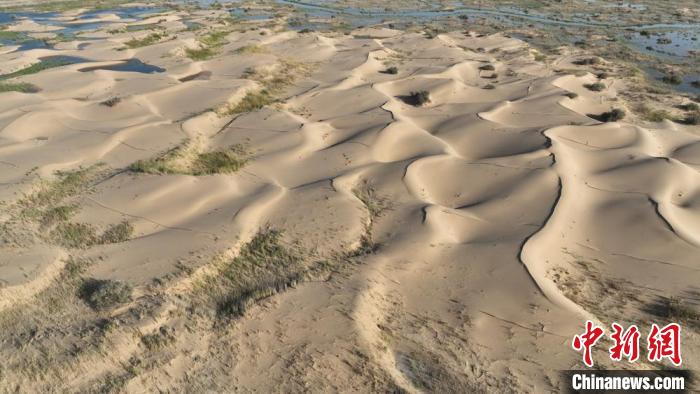A trial of afforestation of 50,000 mu by "seed ball" aerial seeding at the edge of Taklimakan Desert

Trial afforestation is carried out through "seed ball" aerial seeding in the desertified area on the edge of the Taklimakan Desert. Photo by Lin Guoqiang
China News Service, Urumqi, December 2 (Qi Yaping, Lin Guoqiang). Alar City (First Division of the Xinjiang Production and Construction Corps) is located on the northern edge of the Taklamakan Desert. Recently, the city has been experimenting with aerial seeding of “seed balls”, which is expected to transform 50,000 mu desertified area on the edge of the desert.
According to the local natural resource department, this is the first time that “seed balls” of trees are used for large-scale aerial seeding trial afforestation in a desertified area in China.
Targeting the natural environmental conditions of the Taklimakan Desert - the "sea of death", the large-scale aerial seeding afforestation is an attempt to restore the ecology of the desert region, accumulating valuable experience for comprehensive management and restoration of vegetation in local desertified areas.

Checking out the condition of “seed balls”. Photo by Lin Guoqiang
China has a relatively mature technology of aerial seeding afforestation, which has the advantages of high efficiency, low cost, and precise operation area.
In order to help seeds survive the harsh natural conditions in the rainless Taklimakan Desert, scientists and technicians make “seed balls” by wrapping seeds of diversiform-leaved poplar, rose willow (Tamarix ramosissima Ledeb) and other drought and salt tolerant trees and grass seeds in the mixture of red clay, coconut peat, and other organic matter. Red clay can provide a better soil environment for seeds, while coconut peat can quickly absorb and retain moisture when it rains, providing favorable germination conditions for the seeds inside.
In order to ensure the germination rate and survival rate of seeds, Sinoway Forest Technology (Beijing) Co., Ltd. responsible for the afforestation task cooperated with Shaanxi University of Technology this May for an initial 6000 mu trial afforestation attempt in Ganquan Town, Alar City by means of seed ball aerial seeding. The attempt aims to ensure efficient and quality implementation of the 50,000 mu afforestation around the desert later on.
Loading “seed balls” on the plane. Photo by Lin Guoqiang
"The biggest challenge for aerial seeding afforestation in desertified areas is the lack of water," said Wang Xinpeng, General Manager of the aforesaid company, "so we are sowing all kinds of seeds in the Taklimakan Desert, and even a 1% survival rate is a considerable achievement."
The teams experimented with aerial seeding afforestation in batches, continuously comparing different volume and density combinations of “seed balls” to ensure stable water absorption and germination rate when they fall on the ground.
"Through the preliminary tests earlier this year, we have improved the process of “seed balls”. With reduced size and mass, they are relatively lighter and can cover a much larger area when sowed from the plane." Wang Xinpeng said.

Aerial seeding of “seed balls” by the plane. Photo by Lin Guoqiang
Zhong Zhiyong, head of Alar Dingjiang Navigation Co., Ltd., which is in charge of the specific aerial seeding task, said that several thousand mu could be covered per day through this approach, which is much more efficient than manual work and is also very suitable for working in desertified areas. Up to now, more than 30 sorties have been flown, covering an area of about 20,000 mu.

The improved “seed balls” are relatively lighter and allow greater coverage when sowed from the airplane. Photo by Lin Guoqiang
"The short-term plan is to complete about 300,000 mu of aerial seeding afforestation around the city of Alar within five years." Wang Xinpeng said that they would continue to perform effective afforestation in the city on the northern edge of Taklimakan, accumulate experience for afforestation in the whole desert area, and further slow down the process of land desertification.




